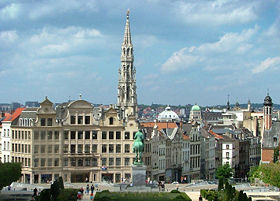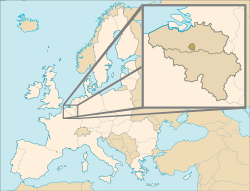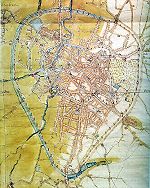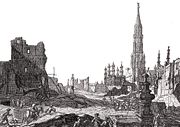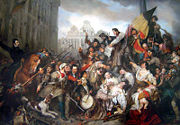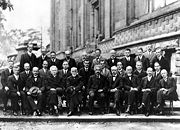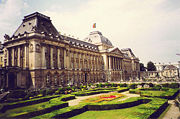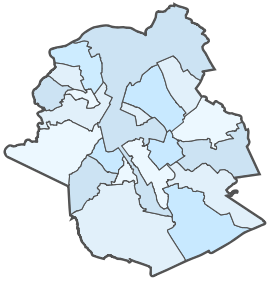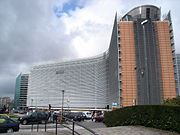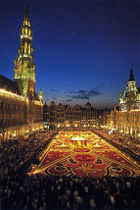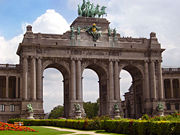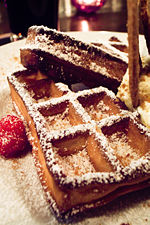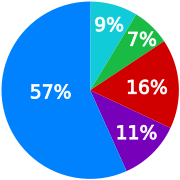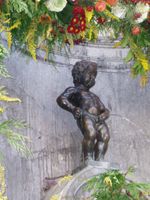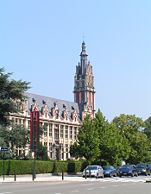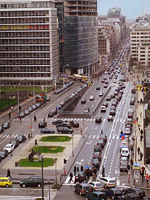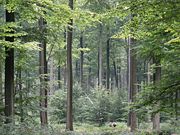Brussels
2008/9 Schools Wikipedia Selection. Related subjects: Europe; European Cities
| Brussels Bruxelles (French) Brussel (Dutch) |
|||
| Brussels-Capital Region | |||
| The old city centre | |||
|
|||
| Nickname(s): Capital of Europe, Comic city | |||
|
Location of Brussels (red)
– in the European Union (teal blue & light blue) |
|||
| Coordinates: | |||
|---|---|---|---|
| Sovereign state | Belgium | ||
| Settled | 580 | ||
| Founded | 979 | ||
| Founded as region | 18 June 1989 | ||
| Municipalities |
List
|
||
| Government | |||
| - Minister-President | Charles Picqué | ||
| Elevation | 13 m (43 ft) | ||
| Population ( 1 January 2007) | |||
| - Region | 1,031,215 | ||
| - Density | 6,389/km² (3,970/sq mi) | ||
| - Metro | 1,350,000 | ||
| Time zone | CET ( UTC+1) | ||
| - Summer ( DST) | CEST ( UTC+2) | ||
| ISO 3166 | BE-BRU | ||
| Website: www.brussels.irisnet.be | |||
Brussels (French: Bruxelles, pronounced [bʁysɛl]; Dutch: Brussel, pronounced [ˈbrɵsəɫ]) is the largest city in Belgium, and the administrative heart of the European Union (EU). The City of Brussels in the Brussels-Capital Region is the country's capital. Brussels has grown from a 10th century fortress town founded by Charlemagne's grandson into a metropolis of over one million inhabitants.
Brussels is also capital of the Brussels-Capital Region, of Flanders and of the French Community of Belgium. It is not, however, the capital of the Walloon Region ( Wallonia), whose capital is Namur.
Although the City of Brussels historically was the city's core, the population has long since outgrown the municipality. Today, the settlement of Brussels is effectively most often synonymous with the more recently established Brussels-Capital Region; one of Belgium's three regions.
Brussels is often considered the de facto capital of the European Union, and hosts key EU institutions such as the Commission, Parliament and the Council. Brussels is a metonymy for the European Union's government. Hence, many other pan-European organisations are also headquartered in the city. NATO is also based in Brussels.
Etymology
The name Brussels comes from the old Dutch Bruocsella, which means marsh (bruoc) and home (sella) or "home in the marsh".
History
Middle Ages
The origin of the settlement that was to become Brussels lies in Saint Gaugericus' construction of a chapel on an island in the river Senne around 580.
The official founding of Brussels is usually situated around 979, because Duke Charles transferred the relics of Saint Gudula from Moorsel to the Saint Gaugericus chapel in Brussels, located on what would be called Saint Gaugericus Island. The Holy Roman Emperor Otto II gave the duchy of Lower Lotharingia to Charles, the banished son of King Louis IV of France in 977, who would construct the first permanent fortification in the city, doing so on that same island.
The county of Brussels was attributed to Lambert I of Leuven, count of Leuven around 1000. In 1047, his son Lambert II, Count of Leuven founded the Saint Gudula chapter.
Because of its location on the shores of the Senne on an important trade route between Bruges and Ghent, and Cologne, Brussels grew quite quickly; it became a commercial centre that rapidly extended towards the upper town ( St. Michael and Gudula Cathedral, Coudenberg, Zavel area...), where there was a smaller risk of floods. As it grew to a population of around 30,000, the surrounding marshes were drained to allow for further expansion. The Counts of Leuven became Dukes of Brabant at about this time (1183/1184). In the 11th century, the city got its first walls.
After the construction of the first walls of Brussels in the early 13th century, Brussels grew significantly. In order to let the city expand, a second set of walls was erected between 1356 and 1383. Today, traces of it can still be seen, mostly because the " small ring", a series of roadways in downtown Brussels bounding the historic city centre, follows its former course.
In the fifteenth century, by means of the wedding of heiress Margaret III of Flanders with Philip the Bold, Duke of Burgundy, a new Duke of Brabant emerged from the House of Valois (namely Antoine, their son), with another line of descent from the Habsburgs (Maximilian of Austria, later Maximilian I, Holy Roman Emperor, married Mary of Burgundy, who was born in Brussels).
Brabant had lost its independence, but Brussels became the Princely Capital of the prosperous Low Countries, and flourished.
Renaissance
Charles V, heir of the Low Countries since 1506, though (as he was only 6 years old) governed by his aunt Margaret of Austria until 1515, was declared King of Spain, in 1516, in the Cathedral of Saint Gudule in Brussels.
Upon the death of his grandfather, Maximilian I, Holy Roman Emperor in 1519, Charles V became the new archduke of the Austrian Empire and thus the Holy Roman Emperor of the Empire " on which the sun does not set". It was in the Palace complex at Coudenberg that Charles V abdicated in 1555. This impressive palace, famous all over Europe, had greatly expanded since it had first become the seat of the Dukes of Brabant, but it was destroyed by fire in 1731. All that remains is an archaeological site.
In 1695, French troops sent by King Louis XIV bombarded Brussels with artillery. Together with the resulting fire, it was most destructive event in the entire history of Brussels. The Grand Place was destroyed, along with 4000 buildings, a third of those in the city. The reconstruction of the city centre, effected during subsequent years, profoundly changed the appearance of the city and left numerous traces still visible today.
Revolution
In 1830, the Belgian revolution took place in Brussels after a performance of Auber's opera La Muette de Portici at De Munt or La Monnaie theatre. On July 21, 1831, Leopold I, the first King of the Belgians, ascended the throne, undertaking the destruction of the city walls and the construction of many buildings. Following independence, the city underwent many more changes. The Senne had become a serious health hazard, and from 1867 to 1871 its entire urban area was completely covered over. This allowed urban renewal and the construction of modern buildings and boulevards which are characteristic of downtown Brussels today.
Modern history
The city has hosted various fairs and conferences, including the fifth Solvay Conference in 1927 and two world fairs: the 1935 world fair and the Expo '58.
Beginning on May 10, 1940, Brussels was bombed by the German army; however, most of the war damage to the city took place in 1944–1945. The North-South Junction was built, completed in 1952. The first Brussels premetro was finished in 1969, and the first line of the Brussels Metro was opened in 1976. The Heysel Stadium disaster took place in Brussels on May 29, 1985. The Brussels Capital Region was founded on June 18, 1989.
Geography
Climate
Brussels is relatively near the coastal areas, and its climate is therefore influenced by marine air masses from the Atlantic Ocean, as well as nearby wetlands. On average (based on measurements the last 100 years), there are approximately 200 days of rain per year in the Brussels-Capital Region..
| Weather averages for Brussels | |||||||||||||
|---|---|---|---|---|---|---|---|---|---|---|---|---|---|
| Month | Jan | Feb | Mar | Apr | May | Jun | Jul | Aug | Sep | Oct | Nov | Dec | |
| Average high °C (°F) | 5 (41) | 6 (43) | 10 (50) | 14 (57) | 18 (64) | 20 (68) | 23 (73) | 23 (73) | 19 (66) | 14 (57) | 9 (48) | 6 (43) | |
| Average low °C (°F) | 1 (34) | 2 (36) | 4 (39) | 6 (43) | 9 (48) | 12 (54) | 14 (57) | 14 (57) | 12 (54) | 8 (46) | 5 (41) | 3 (37) | |
| Precipitation cm (inches) | 5.77 (2.3) | 5.2 (2) | 5.11 (2) | 3.88 (1.5) | 4.42 (1.7) | 5.52 (2.2) | 6.23 (2.5) | 5.61 (2.2) | 5.02 (2) | 5.31 (2.1) | 5.6 (2.2) | 6.22 (2.4) | |
| Source: MSN Weather 2007-10-04 | |||||||||||||
Political centre
Belgian capital
Despite what it name indicates, the Brussels-Capital Region is not the capital of Belgium in itself. The article 194 of the Belgian Constitution lays down that the capital of Belgium is the City of Brussels, a smaller municipality within the capital region that once was the city's core.
However, although the City of Brussels is the official capital, the funds allowed by the federation and region for the representative role of the capital are divided among the 19 municipalities, and some national institutions are sited in the other 18 municipalities. Thus, while de jure only the City of Brussels is entitled to the title of capital city of Belgium, de facto the entire Region plays this role.
The national institutions of the Belgian state are spread loosely around the region. For example the Belgian Federal Parliament and the legislative chambers of the Walloon Region and the Flemish Region.
Flanders and the French community
| The 19 municipalities of the Brussels-Capital Region |
|
The Brussels-Capital Region is one of the three federated regions of Belgium, alongside Wallonia and the Flemish Region. Geographically and linguistically, it is a (bilingual) enclave in the (unilingual) Flemish Region. Regions are one component of Belgium's complex institutions, the three communities being the other component: the Brussels inhabitants must deal with either the French (speaking) community or the Flemish Community for matters such as culture and education.
Brussels is also the capital of both the French Community of Belgium (Communauté française de Belgique in French) and of Flanders (Vlaanderen); all Flemish capital institutions are established here: Flemish Parliament, Flemish government and its administration.
International centre
Brussels has since World War II become the administrative centre of many international organisations. Notably the European Union (EU) and the North Atlantic Treaty Organisation (NATO) have their main institutions in the city, along with 1000 other international organisations and 2000 international corporations. Brussels is third in the number of international conferences it hosts also becoming one of the largest convention centres in the world. The presence of the EU and the other international bodies has for example led to there being more ambassadors and journalists in Brussels than in Washington D.C.. International schools have also been established to serve this presence.
European Union
Brussels is considered as the de facto capital of the European Union due to its history of hosting the EU's institutions, even though the EU has not declared any official capital city. The city plays host to the official seats of the European Commission (in the Berlaymont building) and the Council of the European Union (in the Justus Lipsius building facing it). Furthermore three quarters of the work of the European Parliament takes place in the city at its Brussels hemicycle (its official seat is Strasbourg).
Brussels began to host institutions in 1957, with the executives of the EEC and Euratom which were originally shared with Luxembourg but quickly met in Brussels for practical reasons. In 1965 Brussels gained the right to host the merged Commission and Council, with some concessions to Luxembourg, and over the following years the Parliament established an increasing presence in Brussels, although was required to maintain its presence in Strasbourg by the treaties. Between 2002 and 2004, the European Council also fixed its seat in the city.
Today the presence has increased considerably with the Commission alone occupying 865,000m² within the "European Quarter" in the east of the city. The concentration and density has caused concern that the presence of the institutions has caused a " ghetto effect" in that part of the city. However the presence has contributed significantly to the importance of Brussels as an international centre.
Culture
Architecture
The architecture in Brussels is diverse, and spans from the mediaeval constructions on the Grand Place to the postmodern buildings of the EU institutions.
Main attractions include the Grand Place, since 1988 a UNESCO World Heritage Site, with the Gothic town hall in the old centre, the St. Michael and Gudula Cathedral and the Laken Castle with its large greenhouses. Another famous landmark is the Royal Palace.
The Atomium is a symbolic 103-metre (338 ft) metre tall structure that was built for the 1958 World’s Fair. It consists of nine steel spheres connected by tubes, and forms a model of an iron crystal (specifically, a unit cell. The architect A. Waterkeyn devoted the building to science. Next to the Atomium is the Mini-Europe park with 1:25 scale maquettes of famous buildings from across Europe.
The Manneken Pis, a bronze fountain of a small peeing boy is a famous tourist attraction and symbol of the city.
Other landmarks include the Cinquantenaire park with its triumphal arch and nearby museums, the Basilica of the Sacred Heart, Brussels Stock Exchange, the Palace of Justice and the buildings of EU institutions in the European Quarter.
Cultural facilities include the Brussels Theatre and the La Monnaie Theatre and opera house. There is a wide array of museums, from the Royal Museum of Fine Art to the Museum of the Army and the Comic Museum. Brussels also has a lively music scene, with everything from opera houses and concert halls to music bars and techno clubs.
The city centre is notable for its Flemish town houses. Also particularly striking are the buildings in the Art Nouveau style by the Brussels architect Victor Horta. In the heyday of Art Nouveau new Brussels suburbs were developed, and much buildings are in this style. The architecture of the quarter Schaerbeek, Etterbeek Ixelles, and Saint-Gilles is particularly worth seeing. Another example of Brussels Art Nouveau is the Stoclet Palace, by the Viennese architect Josef Hoffmann. The modern buildings of Espace Leopold complete the picture.
The city has had a renown artist scene for many years. The famous Belgian surrealist René Magritte, for example, studied in Brussels. The city is also a capital of the comic strip; some treasured Belgian characters are Lucky Luke, Tintin, Cubitus, Gaston Lagaffe and Marsupilami. Throughout the city walls are painted with large motifs of comic book characters, and the interiors of some Metro stations are designed by artists. The Belgian Comics Museum combines two artistic leitmotifs of Brussels, being a museum devoted to Belgian comic strips, housed in the former Waucquez department store, designed by Victor Horta in the Art Nouveau style.
The King Baudouin Stadium is a concert and competition facility with a 50,000 seat capacity, the largest in Belgium. The site was formerly occupied by the Heysel Stadium, which in 1985 saw one of the worst disasters in European football, when 39 deaths and over 400 serious injuries were suffered after English hooligans fell on Italian football fans, sparking a mass panic.
Arts
Brussels contains over 40 museums, including the Museum of Modern Art, and the Royal Museums of Fine Arts of Belgium. The museum has an extensive collection of various painters, such as the Flemish painters like Brueghel, Rogier van der Weyden, Robert Campin, Anthony van Dyck, and Jacob Jordaens.
Gastronomy
Brussels is known for its local waffle, its chocolate, its french fries and its numerous types of beers . The Brussels sprout was first cultivated in Brussels, hence its name.
The gastronomic offer includes approximately 1,800 restaurants, and a number of high quality bars. The Belgian cuisine is known among connoisseurs as one of the best in Europe. In addition to the traditional restaurants, there is a large number of cafés, bistros and the usual range of international fast food chains. The cafés are similar to bars, and offer beer and light dishes, coffee houses in the usual sense are the Salons de Thé. Also widespread are brasseries, which usually offer a large number of beers and typical national dishes.
The Belgian cuisine is characterized by the combination of French cuisine with the more hearty Flemish fare. Notable specialities include Brussels waffles (gaufres) and mussels (usually as "moules frites," served with fries). The city is a stronghold of chocolate and pralines manufacturers with traditional companies like Godiva, Neuhaus and Leonidas. Numerous friteries are spread throughout the city, and in tourist areas, fresh, hot, waffles are also sold on the street.
In addition to the regular selection of Belgian beer, the famous lambic style of beer is only brewed in and around Brussels, and the yeasts have their origin in the Senne valley. In mild contrast to the other versions, Kriek (cherry beer) enjoys outstanding popularity, as it does in the rest of Belgium. Kriek is available in almost every bar or restaurant.
Economy
Serving as the centre of administration for Europe, Brussels' economy is largely service-oriented. It is dominated by regional headquarters of multinationals, by European institutions, by various administrations, and by related services, though it does have a number of notable craft industries, such as the Cantillon Brewery, a lambic brewery founded in 1900.
Languages
Originally a Dutch-speaking city, Brussels is nowadays officially bilingual French-Dutch. French is the mother tongue of the majority of the population and the lingua franca. Research in the city's archives shows that Dutch was by far the most widely used language in local administration until the French occupation (1793-1815), even though French had been the language of the local governors since the Burgundian era. From 1880 on, more and more Dutch-speaking people became bilingual, resulting in a rise of monolingual French-speakers after 1910. Halfway through the 20th century the number of monolingual French-speakers carried the day over the (mostly) bilingual Flemish inhabitants.
During the 19th century most dialect-speakers (speaking the local dialect of Dutch) turned to French rather than to Dutch as their language of culture. The main reasons for this were the higher prestige of the French language at the time (even the Flemish elites had adopted French), the perception that Dutch was the language of rural and poor Flanders and the fact that the Belgian administration was solely conducted in French. The education system was almost exclusively French-speaking, which hampered the spread of the Dutch standard language and contributed to low-class image of Dutch. As a result, people would often speak a Dutch dialect in private but French in public occasions. Even today, it is not uncommon to meet (older) French-speaking "Bruxellois" who are unable to express themselves in standard Dutch but who speak or at least understand the Brabantian dialect.
A linguistic curiosity is Marols (Marollien), a variant of the Dutch dialect of Brussels heavily influenced by the Walloon of Liège, which used to be spoken mostly in the Marolles/ Marollen, a central section of the city. Today, all Brussels dialects are on the verge of extinction.
Nowadays, the Brussels Capital Region is officially bilingual French-Dutch. There are no official linguistic statistics since the State-run decennial linguistic census has been abolished after the fixation of the Belgian language border. All studies carried out can only be estimations.
As Brussels is the capital of a country of which 60% of the inhabitants are Dutch speakers, and the Brussels Region is completely surrounded by the Flemish region, it is logical that many Dutch speakers from the periphery come to the city for working, shopping and going out. So, although the lingua franca is French, knowledge of Dutch is considered highly desirable. One of the consequences of this change of attitude towards the Dutch language is, for example, that most children in Dutch-speaking schools in Brussels do not speak Dutch at home. Janssens estimates that 28.23% of the population have a good to perfect knowledge of Dutch (either as a first or as a second language). For English this is 35.4% and for French 95%, due to its role as lingua franca.
The occasional imprecision of linguistic pairing can be quite amusing. Whilst some ancient streets have only their original Dutch name (e.g. Coudenberg), others were originally named in French and have had their later Dutch names revised. For instance the Rue du Beau Site in Ixelles/Elsene bears two bilingual nameplates, the older giving, as the Dutch version, the hastily translated Schoon-Zicht Straat and the more recent giving the more idiomatic Welgelegenstraat. Other such pairs are Regentiestraat/Regentschapstraat and Koopmansstraat/Koopliedenstraat.
Due to the city's growth beyond the limits of the Brussels Capital Region, the periphery, which is institutionally part of Dutch-speaking Flanders, has attracted a large French-speaking population. In some of the municipalities immediately bordering the Brussels Capital Region, the population became majority French-speaking during the second half of the 20th century, in a few cases currently numbering over 70%. Because of the refusal of many of these to use Dutch, this is one of the major sources of linguistic conflict in Belgium, particularly in the Brussels-Halle-Vilvoorde region.
Education
There are several universities in Brussels. The two main universities are the Université Libre de Bruxelles, a French-speaking university with about 20,000 students in three campuses in the city (and two others outside), and the Vrije Universiteit Brussel, a Dutch-speaking university with about 10,000 students. Both universities originate from a single ancestor university founded in 1834, namely the Free University of Brussels, which was split in 1970 at about the same time the Flemish and French Communities gained legislative power over the organisation of higher education.
Other universities include the Facultés Universitaires Saint Louis with 2,000 students, , the Catholic University of Brussels ( Katholieke Universiteit Brussel) , the Royal Military Academy, a military college established in 1834 by a French colonel and two drama schools founded in 1982: the Dutch-speaking Koninklijk Conservatorium and the French-speaking Conservatoire Royal.
Still other universities have campuses in Brussels, such as the Université Catholique de Louvain that has had its medical faculty in the city since 1973. In addition the Boston University Brussels campus was established in 1972 and offers masters degrees in business administration and international relations. Due to the post-war international presence in the city, there are also a number of international schools, including the International School of Brussels with 1,450 pupils between 2½ to 18, the British School of Brussels, and the four European Schools serving those working in the EU institutions.
Transport
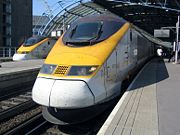
Connections
Brussels is served by Brussels Airport, located in the nearby Flemish municipality of Zaventem, and by the much smaller so-called Brussels South Charleroi Airport, located near Charleroi (Wallonia), some 50 km (30 mi) from Brussels. Brussels is also served by direct high-speed rail links: to London by the Eurostar train via the Channel Tunnel (1hr 51 min); to Amsterdam, Paris and Cologne by the Thalys; and to Cologne and Frankfurt by the German ICE.
Public transport
The Brussels Metro dates back to 1976, but underground lines known as premetro have been serviced by tramways since 1968. A comprehensive bus and tram network also covers the city.
Brussels also has its own port on the Brussels-Scheldt Maritime Canal located in the northwest of the city. The Brussels-Charleroi Canal connects the industrial areas of Wallonia.
An interticketing system means that a STIB/MIVB ticket holder can use the train or long-distance buses inside the city. The commuter services operated by De Lijn, TEC and SNCB/NMBS will in the next few years be augmented by a metropolitan RER rail network around Brussels.
Since 2003 Brussels has had a car-sharing service operated by the Bremen company Cambio in partnership with STIB/MIVB and local ridesharing company taxi stop. In 2006 shared bicycles were also introduced.
Road network
In mediaeval times Brussels stood at the intersection of routes running north-south (the modern Hoogstraat/Rue Haute) and east-west (Gentsesteenweg/Chaussée de Gand-Grasmarkt/Rue du Marché aux Herbes-Naamsestraat/Rue de Namur). The ancient pattern of streets radiating from the Grand Place in large part remains, but has been overlaid by boulevards built over the River Zenne/Senne, over the city walls and over the railway connection between the North and South Stations.
As one expects of a capital city, Brussels is the hub of the fan of old national roads, the principal ones being clockwise the N1 (N to Breda), N2 (E to Maastricht), N3 (E to Aachen), N4 (SE to Luxembourg) N5 (S to Rheims), N6 (SW to Maubeuge), N8 (W to Koksijde) and N9 (NW to Ostend) . Usually named steenwegen/chaussées, these highways normally run straight as a die, but on occasion lose themselves in a maze of narrow shopping streets.
As for motorways, the town is skirted by the European route E19 (N-S) and the E40 (E-W), while the E411 leads away to the SE. Brussels has an orbital motorway, numbered R0 (R-zero) and commonly referred to as the "ring" (French: ring Dutch: grote ring). It is pear-shaped as the southern side was never built as originally conceived, owing to residents' objections.
The city centre, sometimes known as "the pentagon", is surrounded by the " Small ring" (Dutch: kleine ring, French: petite ceinture), a sequence of boulevards formally numbered R20. These were built upon the site of the second set of city walls following their demolition. Metro line 2 runs under much of these.
On the eastern side of the city, the R21 (French: grande ceinture, grote ring in Dutch) is formed by a string of boulevards that curves round from Laken ( Laeken) to Ukkel ( Uccle). Some premetro stations (see Brussels Metro) were built on that route. A little further out, a stretch numbered R22 leads from Zaventem to Sint-Job.
Twin cities
Brussels is twinned with the following 14 cities:
|
